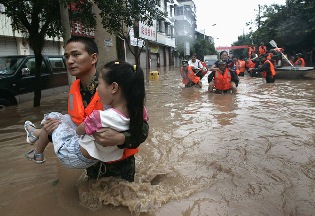 Man-made greenhouse gas emissions are linked to more frequent heavy rainfall, two studies published found on Wednesday, portraying a clearer human fingerprint after a spate of floods around the world.
Man-made greenhouse gas emissions are linked to more frequent heavy rainfall, two studies published found on Wednesday, portraying a clearer human fingerprint after a spate of floods around the world.
Scientists agree that greenhouse gas emissions are warming the world and expect that in turn would lead in the future to more evaporation of water, more moist air and heavier rainfall.
But the two new papers were the first to pin an increase in heavy rainfall in the second half of the last century directly on climate change, as well as one particular extreme flood in Britain.
“The two studies demonstrate that a human impact upon the intensification of rainfall and associated flooding is already detectable,” said Richard Allan at the department of meteorology, University of Reading, in Britain.
A Canadian study published in the journal Nature analyzed a general increase in heavy rainfall globally from 1951-1999, and for the first time matched those observations with climate simulations, where the effects of man-made greenhouse gas emissions were included.
“We were able to establish a link between anthropogenic influence and the changes in precipitation,” said co-author Xuebin Zhang, from Environment Canada, a government agency.
“The caveat is we haven’t been able to identify, to quantify, how big is that influence. That is difficult because of the limitations in observations.”
A separate paper, also published in Nature, went a step further and forged a link between climate change and a particular extreme flood in Britain in 2000.
The authors found that the flood was more likely when greenhouse gases were included in simulations than without.
“In two out of three cases we found around a doubling of risk,” said co-author Myles Allen from Oxford University.
Extreme weather caused devastating floods in Pakistan and China in 2010, which was tied as the warmest year since records began, and heavy rains in Australia late last year and early 2011 disrupted coal mines and damaged transport infrastructure.
INFANCY
The British study used several thousand computers to simulate the weather in 2000 across England and Wales, where October and November were the wettest since records began in 1766, before the industrial revolution.
The models ran simulations with and without the effects of man-made greenhouse gases on climate change.
The study was striking in trying to attribute man-made climate change to a particular event, given all the complex, chaotic events that contribute to a given storm.
“The evidence for human influence on climate is now even more compelling,” said British energy and climate secretary Chris Huhne, responding to the paper.
But the methods it used were in their infancy, said Roger Pielke at the University of Colorado, and the authors acknowledged more research was needed.
For example, one in 10 simulations showed that greenhouse gas emissions increased the chance of the flood by less than 20 percent. “There’s quite a lot of uncertainty around this and we’re hoping other centers will try to reproduce this and we’ll see what results they get,” said Allen.

